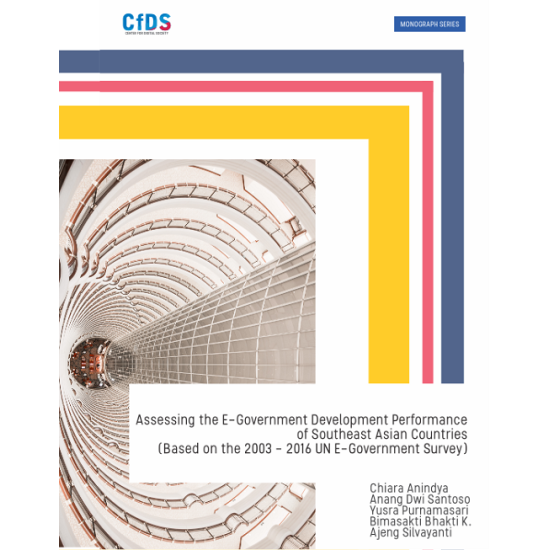

100% ORIGINAL


Assessing The E-Goverment Development Performance of Southeast Asian Contries: Based on the 2003- 2016 E-Goverment Survey
- Stock: Gudang Penerbit
- Penulis: Chiara Anindya
- Penerbit: UGM Press
- Model: 9786023862917
Rp38,000
Rp26,220
-550x550.png.webp) | Pengiriman Ke DKI JAKARTA Ongkos Kirim Rp 0 Khusus member Grobprime (GRATIS TRIAL) | JOIN |
Deskripsi
In the Information Age we live in, governments around the world are prov’ded with a variety of tools to aid their practices. Traditionally deemed as a bureaucratic practice, the incorporation of information and communications technologies (ICTs) allows governments to easily share public information. Egovernment allows citizens to claim an active role in the governing process. The practice of e-government is also seen to be more cost-efficient, as the government can reach its citizens in just a click. Naturally, e-government will continue to develop,adjacenttothe development oftechnology itself.
In 2001, the United Nations (UN) started an exhaustive attempt to measure the global practice of e-government. The series of surveys began with an eightyone paged report, titled “Benchmarking E-Government: A Global Perspective.†These surveys would later be known as the UN E-Government Survey. As stated in their 2003 publication, “information technology applications, especially egovernment programs, are increasingly becoming the cornerstone of government operations†(p. 4). One of the primary outcomes of the first UN EGovernment Survey was the E-Government Readiness Index, a treasured instrumentthe UN would later use in theirsubsequent research projects.
Until December 2016, the UN has released nine survey reports on global egovernment. The reports were published respectively in 2001, 2003, 2004, 2005, 2008, 2010, 2012, 2014, and 2016. However, the 2001 issue was not included as data for this monograph, as it remains to only be an early effort in benchmarking the global progress of e-government. Each report addresses specific issues, such as e-inclusion, sustainable development, connected governance, etc. The world rank of e-government practice measured by the EGovernment Development lndex (EGDl) is included in each report. The EGDI was developed using the same components of the E-Government Readiness index butdifiersinthenumberofquestions.
Although the report doesn't address the thorough practice of e-government in all countries, it offers insight on the global, regional, and sub-regional digital government trends. Naturally, American and European countries appear frequently on the survey's top ranks. However, some Asian countries were starting to claim their place amongst the world's best e-government practices, with the Republic of Korea beingthe bestworldwide in 2010,2012, and 2014.
In 2001, the United Nations (UN) started an exhaustive attempt to measure the global practice of e-government. The series of surveys began with an eightyone paged report, titled “Benchmarking E-Government: A Global Perspective.†These surveys would later be known as the UN E-Government Survey. As stated in their 2003 publication, “information technology applications, especially egovernment programs, are increasingly becoming the cornerstone of government operations†(p. 4). One of the primary outcomes of the first UN EGovernment Survey was the E-Government Readiness Index, a treasured instrumentthe UN would later use in theirsubsequent research projects.
Until December 2016, the UN has released nine survey reports on global egovernment. The reports were published respectively in 2001, 2003, 2004, 2005, 2008, 2010, 2012, 2014, and 2016. However, the 2001 issue was not included as data for this monograph, as it remains to only be an early effort in benchmarking the global progress of e-government. Each report addresses specific issues, such as e-inclusion, sustainable development, connected governance, etc. The world rank of e-government practice measured by the EGovernment Development lndex (EGDl) is included in each report. The EGDI was developed using the same components of the E-Government Readiness index butdifiersinthenumberofquestions.
Although the report doesn't address the thorough practice of e-government in all countries, it offers insight on the global, regional, and sub-regional digital government trends. Naturally, American and European countries appear frequently on the survey's top ranks. However, some Asian countries were starting to claim their place amongst the world's best e-government practices, with the Republic of Korea beingthe bestworldwide in 2010,2012, and 2014.
Ulasan
Tags: Chiara Anindya,
Anang Dwi Santoso,
Yusra Purnamasari,
Bimasakti Bhakti K.,
Ajeng Silvayanti,
BK10
Rekomendasi Produk Lainnya
Dalam kehidupan sehari-hari, sering kita jumpai orang-orang yang tidak memiliki "kebranian" untuk hidup, apalagi berani sukses. Banyak orang yang lebi..
Rp28,980 Rp42,000
"Siapa sangka tumpeng, piza, donat, wafel, sate ataupun mie ayam bisa dibuat dari puding? Bentuknya sepintas mirip aslinya, tapi manakala disantap..hm..
Rp87,500 Rp125,000
4 review(s)
Novel ini berdasarkan kisah nyata. Berkisah tentang kehidupan sebuah keluarga yang berasal dari Padang, Sumatra Barat.Sewaktu kecil, sang kakek diting..
Rp21,000 Rp30,000
4 review(s)
Sinopsis Buku ini merupakan buku pertama di Indonesia yang memuat secara komprehensif mulai dari sejarah, cara kerja, penggunaan, dan ..
Rp17,940 Rp26,000
Saat bumi diserang oleh gerombolan serangga raksasa, siapakah yang akan kau panggil? Tentu saja Battle Braves!
Anak-anak pecinta serangga siap menyela..
Rp68,600 Rp98,000
Suara pintu yang menutup erat, meskipun tidak dibanting dengan kasar, bergaung dalam kehampaan rumahku. Getarannya menghempaskanku ke kursi di samping..
Rp38,360 Rp54,800
Sinopsis Buku ini ini akan menuntun anda dalam menggapai cita-cita anda menjadi seorang geologist yang handal.Penulis &nb..
Rp24,150 Rp35,000
Lily Patterson tidak pernah mengira, perjalanan ke Roma akan mengubah rencana hidupnya. Ia harus menunda keinginan untuk mengejar mimpi yang tak terar..
Rp41,300 Rp59,000
Menurut Lifshitz, tulisan-tulisan Marx menekankan kesenjangan perkembangan sosial dengan artistik, dan memandang sasaran tertinggi estetika Marx adala..
Rp36,750 Rp49,000
Al Aliim: Mushaf 2 Warna Besar HCISBN : 9786027317451JUMLAH HALAMAN : 612BULAN/TAHUN TERBIT : 7/2011BERAT : 1.236 KgLEBAR x PANJANG : 21 x 29COVER : H..
Rp123,750 Rp165,000
Jamur kancing merupakan jamur yang paling banyak dibudidayakan di seluruh dunia. Teksturnya yang mirip daging dan kandungannya yang rendah kalori memb..
Rp26,750
Anggina Dimitri membangun benteng setinggi-tingginya dari orangorang di sekitar. Persahabatannya dengan Abi, bos tampan di tempat kerja paruh waktunya..
Rp45,500 Rp65,000
8 review(s)
Yuki dan Atsuko terkejut mendengar alasan anak pindahan bersekolah di SMA mereka. Ternyata ia melihat mayat sahabatnya yang bunuh diri.Yuki menganggap..
Rp93,750 Rp125,000
Bagaimana kisah Nabi Yunus yang selamat setelah dimakan ikan paus? Bagaimana kisah Nabi Musa dengan tongkatnya yang bisa berubah menjadi ular dan juga..
Rp59,250 Rp79,000
Kain-kain tradisional Indonesia tak terhitung jumlahnya. Kain-kain yang disebut wastra ini memukau banyak bangsa di dunia. Sebagai bangsa Indonesia, k..
Rp105,000 Rp150,000
Goyi dan Pipi pergi ke pasar buah Bersama. Begitu mereka tiba di sana, wahh… mereka melihat banyak sekali warna! Ada yang merah, kuning, jingga, hijau..
Rp49,680 Rp69,000
No matter what, no matter how, nothing is impossible for Allah. Kita tentu pernah merasakan apa itu susah. Juga pasti pernah jatuh bangun berjuang dal..
Rp68,400 Rp95,000
544 review(s)
BillyJumlah Halaman : 636.0Tanggal Terbit : 24 Jun 2019ISBN : 9786024021467Penerbit : Mizan Millenial CreativaBerat : 0.508 kgLebar : 13.0 cmPanjang :..
Rp90,000 Rp125,000
4 review(s)
To the World! Mendengar penggalan salam ini, kamu pasti sudah nggak asing lagi dengan grup yang dianggap memiliki penampilan super energik dan mendeta..
Rp63,000 Rp90,000
Super Top No.1 TPA dan Psikotes Masuk SMP & SMAJumlah Halaman : 240
Tanggal Terbit : Feb 12, 2018
ISBN : 9786024525866
Penerbit : Gramedia Widi..
Rp63,000 Rp90,000




















